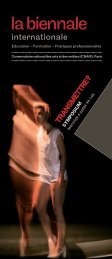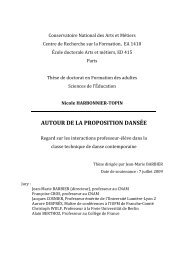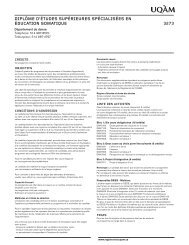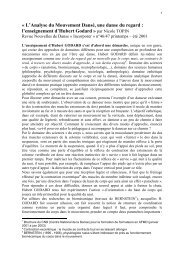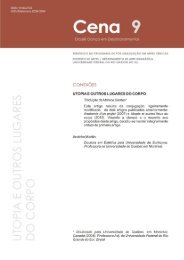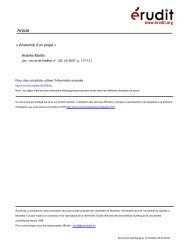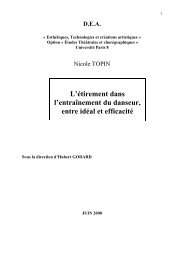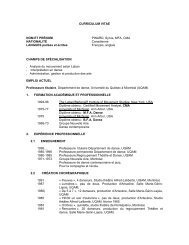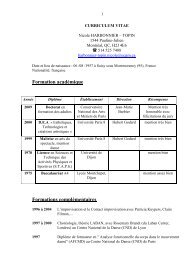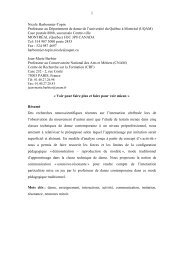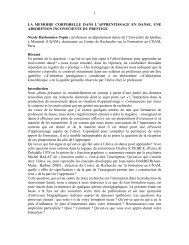Day 2 - Département de danse - UQAM
Day 2 - Département de danse - UQAM
Day 2 - Département de danse - UQAM
Create successful ePaper yourself
Turn your PDF publications into a flip-book with our unique Google optimized e-Paper software.
10:45am-12:15pm<br />
a) Theatre’s New Frontier: Bishop<br />
Multimedia, Participatory Technology, and Twenty-First-Century Theatre Experience<br />
Curated Panel Mo<strong>de</strong>rator: Christian Bock (University of Victoria)<br />
“From Radical to Relational: Digital Media, Oppositionality and Political Intervention in<br />
Contemporary Canadian Theatre.” Kimberley McLeod (York University)<br />
Alan Filewod argues that in contemporary performance, “Digital media is both the means and the form of the reconstitution of<br />
activist theatre: it disrupts and relocates cultural genealogies, reterritorializes artistic traditions, produces new structures.<br />
Digitalization is the enabling condition, then, of new theatricalities” (292). In November 2011, Quebec playwright Oliver<br />
Choinière created a digital performance that, in line with Filewod’s claim, challenged existing theatre conventions and explored<br />
new possibilities for activist performance interventions. His performance, Project blanc, used prerecor<strong>de</strong>d audio on MP3<br />
players, which participants clan<strong>de</strong>stinely listened to while watching a production of L’École <strong>de</strong>s femmes at Montreal’s Théâtre<br />
du Nouveau Mon<strong>de</strong>. The audio was critical of both the production and the theatre’s role as a commercial institution. In this<br />
paper, I investigate the relationship between this production’s oppositional stance and use of digital tools. I argue that<br />
Choinière’s protest performance creates affinity and proximity within his audience, thus working against what Jason Farman<br />
refers to as the “distancing-through-proximic” that usually occurs when individuals are connected to mobile <strong>de</strong>vices in public.<br />
Yet, at the same time, I explore how the production’s own exclusivity and antagonistic tone ironically un<strong>de</strong>rmines Choinière’s<br />
critical stance. I conclu<strong>de</strong> my paper by contrasting Choinière’s approach with another digital site-specific performance:<br />
Jonathan Goldsbie’s Route 501 Revisited. In discussing this second example, which has participants ri<strong>de</strong> on a Toronto<br />
streetcar and communicate through a Twitter hashtag, I hope to emphasise the potential for mobile technologies to politicize<br />
spaces and users via performance. While Goldsbie’s work is less overtly political in its aims, his encouragement of<br />
collaborative engagement contrasts with Choinière’s more traditional narrative approach and oppositionality. Goldsbie’s piece<br />
allows users to physically use new technologies, which breaks down hierarchies of authorship and encourages participants to<br />
actively re-situate their relationship to socially inscribed space.<br />
“Dramaturgical Approaches in Gamified Theatre.” Cassandra Silver (University of Toronto)<br />
There is a spectrum of emergent transmedia storytelling that combines the ethos of gaming with the narrative structures and<br />
performance practices of theatre. From the perspective of gaming studies, these projects are often called alternate reality<br />
games (commonly abbreviated as ARGs); some theatre and performance scholars, not yet entirely comfortable situating this<br />
practice insi<strong>de</strong> their disciplinary boundaries, invoke terms like adventure theatre and interactive drama. While consi<strong>de</strong>rable<br />
attention has been given by gaming studies scholars to ways in which games employ theatre and performance, the inverse is<br />
not correspondingly true. In an effort to create a space for a critical performance studies discourse about this emergent<br />
practice, this paper offers a dramaturgical reading of the recent project ZED.TO by The Mission Business. ZED.TO was an<br />
eight-month long, real-time, interactive, and transmedia art project that told the story of the end of the world. The creative team<br />
combined eight live events that unfol<strong>de</strong>d in 2012 with robust online interactive storytelling; ultimately, they engaged with<br />
several thousand spectator-participants in Toronto, and nearly ten times as many users online (ZED.TO). While this paper<br />
does not intend to typify all ARGs—there are most certainly examples that do not align with the mo<strong>de</strong>l that ZED.TO offers—the<br />
intention in this dramaturgical reading of gamified theatre is to explore an interactive evolution of performance practice. In<br />
interrogating the narrative seams and sutures between theatre and games, this paper seeks to offer a mo<strong>de</strong>l for theatre and<br />
performance scholars so that they might engage with interactive storytelling.<br />
“Schizo-visuality and the Fractioning of Space.” Kyle Ahluwalia (University of Ottawa)<br />
As mediated and multi-media theatre becomes increasingly popular in Canada, this paper accepts that it is a part of 21 st<br />
century theatre and moves beyond the ontological question of “is it theatre.” Instead, I propose to start adapting theories and<br />
exploring notions of how and why vi<strong>de</strong>o projection can be used in the theatre. Does it matter if we can see the source and the<br />
image? What if the image has been altered? Does seeing the technical equipment which allows for the vi<strong>de</strong>o projection<br />
matter? These are the questions which will gui<strong>de</strong> this paper.<br />
By applying Murray Schafer’s term schizophonia (the separation of a sound from its source) to vision, one can look at the<br />
separation of the actor and the visual presented to the audience. This lens can be used to study shows where the public can<br />
see both the actor and the mediated version (Leo presented by NTE and Circle of Eleven; Ubu CC’s Jackie, Charleroi Danses’<br />
Kiss and Cry), the public only has access to the mediated version which is projected live (Comédie <strong>de</strong>s <strong>de</strong>ux rives’ Cimetiere<br />
<strong>de</strong>s voitures at the University of Ottawa) and cases where a pre-recor<strong>de</strong>d vi<strong>de</strong>os are played back in front of the audience (Ubu<br />
CC’s Les Aveugles; Ottawa Shakespeare Company’s Julius Ceasar). Using Josette Féral’s term the Effect of Presence (effet<br />
<strong>de</strong> presence), this paper looks to un<strong>de</strong>rstand if there are patterns which govern schizovisuality in the theatre and its ability to<br />
allow projected characters to appear to have presence on the stage (Effect of Presence). Looking at work created in or<br />
presented in Canada, this paper focuses on the character’s body and the ways in which vi<strong>de</strong>o can be introduced into<br />
performance in or<strong>de</strong>r to create a bodily presence for character’s who are otherwise physically absent.<br />
22



